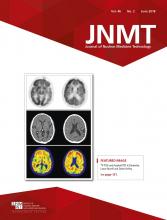Kathy S. Thomas, MHA, CNMT
June represents a professional celebration for the Society of Nuclear Medicine and Molecular Imaging. It’s a time when the nuclear medicine community comes together for its Annual Meeting to share knowledge, recognize excellence, and celebrate the completion of another successful leadership year.
For the Journal of Nuclear Medicine Technology (JNMT), June represents the continuation of the new pathway being forged through the team effort of the associate, consulting, and international editors for developing and expanding new ideas and topics of interest for our readership. One example is the development, suggested by our international consulting editors, of the JNMT Twitter Club. This program provides members and nonmembers with an additional educational opportunity, utilizing Twitter as the discussion medium. Topics of interest identified from the current issue of JNMT are discussed in 280 characters or fewer. Educational credit is available for free to members successfully completing the short quiz available for 1 week following the Twitter chat and for $15 for nonmembers. The beta test for the JNMT Twitter Club in February allowed organizers and participants the opportunity to participate in a program that has been enjoyed by our peers in the European countries for several years. April was the official launch of #JNMTclub. The topic of conversation, “The Impact of Credentials and Continuing Education on Personnel in the Nuclear Cardiology Laboratory on its Operational Quality” (J Nucl Med Technol. 2018;46:53–58), generated a lively discussion, with both pros and cons regarding the benefits of acquiring additional credentials (e.g., NCT, PET, or CT) and the continuing education required to maintain those credentials on overall operational quality. We hope that as the word gets out we will continue to increase participation in the JNMT Twitter Club and add topics of interest for nuclear medicine professionals around the world.
In this issue, three continuing education offerings provide the readership with a wide diversity of topics. The first topic, “Statistics Refresher for Molecular Imaging Technologists–Part 2,” completes the discussion to enhance the reader’s understanding of basic clinical statistics. The second educational offering launches the first in a series on pharmacology and pharmacodynamics designed to provide the readership with a comprehensive discussion of pharmaceuticals and radiopharmaceuticals used in nuclear medicine and molecular imaging. The topic of the final continuing education article was developed by this issue’s associate editors, April Mann and Danny Basso. April was also lead author on this article, which takes a close look at best practice for one of the most common procedures performed in nuclear medicine today: ventilation/perfusion lung imaging. As a complement to that continuing education article, the Practical Protocol Tip for this issue will be Pulmonary (V/Q) Imaging.
The Educators’ Forum continues to support our educators with two excellent articles this month. The first article takes a close look at the relationship between a clinical instructor’s behavior and a student’s clinical engagement. The second article discusses a workshop designed to enhance instructional skills in a clinical setting.
The scientific articles and teaching case studies included in this issue also provide a wide diversity of topics. The scientific articles provide discussions on myocardial perfusion imaging with 13N-ammonia, lymphoscintigraphy of chylous anomalies, online educational materials for nuclear medicine patients, a comparison of maximum-likelihood expectation maximization algorithm versus windowed filtered backprojection, and a closer look at two promising radiopharmaceuticals: 68Ga DOTA and 18FFB-A20FMDV2. The teaching case studies offer findings pertaining to hypertrophic osteoarthropathy, false-positive dopamine transporter imaging, 18F-FDG and amyloid PET in dementia, and the incremental value of SPECT/CT in the detection of viable femoral head and upper femoral epiphysis.
In my first editorial, I noted the importance of the peer-review process for each article published in the JNMT. This process is only as good as the volunteers willing to share their expertise by becoming reviewers for manuscripts submitted to the JNM and JNMT for publication. We currently have a dedicated group of reviewers; however, we desperately need more technologist reviewers. If you are interested in becoming a reviewer for the JNMT, please visit the JNMT manuscript submission website (https://submit-jnm-snmjournals.org/) or contact me (ksthomas0412@msn.com).
The growth and development of the JNMT relies, in part, on the input of its readership. Please contact me with your comments and suggestions. With your help, we will continue to enhance the only peer-reviewed publication dedicated to nuclear medicine technology.








